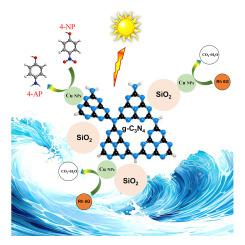Engineering Cu-loaded SiO₂/g-C₃N₄ photocatalysts for efficient visible-light-driven removal of organic pollutants
IF 5.4
3区 化学
Q1 CHEMISTRY, INORGANIC & NUCLEAR
引用次数: 0
Abstract
The efficient elimination of organic contaminants in water remains a significant challenge due to their stability and complexity, demanding advanced, affordable photocatalysts. In this study, a novel, low-cost Cu@SiO₂/g-C₃N₄ composite was synthesized via integration of rice-husk-derived mesoporous silica with g-C₃N₄ nanosheets and subsequent copper nanoparticle loading (0.5–2 wt%) by chemical reduction. The prepared nanocomposites were characterized by various techniques, confirming reasonable porosity, strong visible light absorption, and stable morphology. The optimized 2 % Cu@SiO₂/g-C₃N₄ exhibited exceptional photocatalytic activity: complete reduction of 4-nitrophenol in just 2.5 min and more than 93 % degradation of Rhodamine 6G within 70 min under visible light. Based on comprehensive characterization, the enhanced performance arises from synergies among the electron-rich g-C₃N₄ core, mesoporous SiO₂ serving as an electron mediator, and Cu nanoparticles acting as an electron reservoir, which together strongly suppress electron–hole recombination. Kinetic comparisons show up to 16-fold and 172-fold increases in reaction rates for 4-NP and Rh 6G relative to pristine g-C₃N₄, respectively. Structural and morphological integrity remained unchanged after multiple photocatalytic cycles, confirming substantial stability. This work establishes Cu@SiO₂/g-C₃N₄ as a benchmark sustainable photocatalyst with outstanding efficiency for solar-driven water purification and organic transformation.

负载cu的SiO₂/g-C₃N₄光催化剂,用于高效可见光驱动去除有机污染物
由于水中有机污染物的稳定性和复杂性,有效消除水中有机污染物仍然是一个重大挑战,需要先进的、负担得起的光催化剂。在这项研究中,通过将稻壳衍生的介孔二氧化硅与g-C₃N₄纳米片整合,然后通过化学还原将铜纳米颗粒加载(0.5-2 wt%),合成了一种新型的低成本Cu@SiO₂/g-C₃N₄复合材料。通过各种技术表征所制备的纳米复合材料,孔隙率合理、可见光吸收强、形貌稳定。优化后的2% Cu@SiO₂/g-C₃N₄具有优异的光催化活性:在可见光下,4-硝基苯酚在2.5 min内完全还原,罗丹明6G在70 min内降解93%以上。综合表征表明,富电子的g-C₃N₄核、介孔SiO₂作为电子介质、Cu纳米粒子作为电子储集层三者协同作用,有效抑制了电子-空穴复合。动力学比较表明,相对于原始的g-C₃N₄,4-NP和Rh 6G的反应速率分别提高了16倍和172倍。经过多次光催化循环后,结构和形态完整性保持不变,证实了相当的稳定性。这项工作建立了Cu@SiO₂/g-C₃N₄作为基准可持续光催化剂,在太阳能驱动的水净化和有机转化中具有出色的效率。
本文章由计算机程序翻译,如有差异,请以英文原文为准。
求助全文
约1分钟内获得全文
求助全文
来源期刊

Inorganic Chemistry Communications
化学-无机化学与核化学
CiteScore
5.50
自引率
7.90%
发文量
1013
审稿时长
53 days
期刊介绍:
Launched in January 1998, Inorganic Chemistry Communications is an international journal dedicated to the rapid publication of short communications in the major areas of inorganic, organometallic and supramolecular chemistry. Topics include synthetic and reaction chemistry, kinetics and mechanisms of reactions, bioinorganic chemistry, photochemistry and the use of metal and organometallic compounds in stoichiometric and catalytic synthesis or organic compounds.
 求助内容:
求助内容: 应助结果提醒方式:
应助结果提醒方式:


